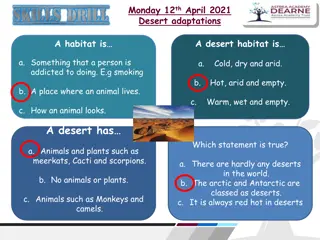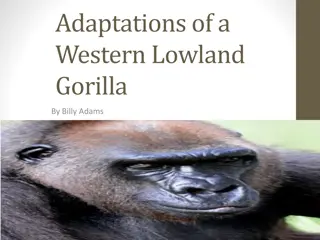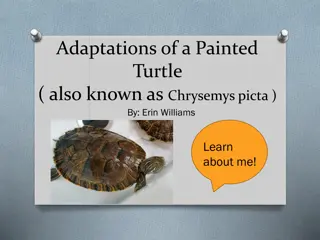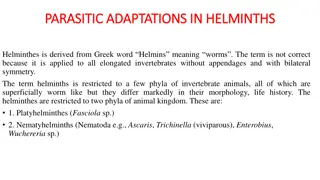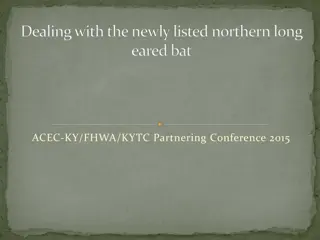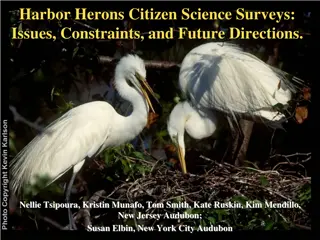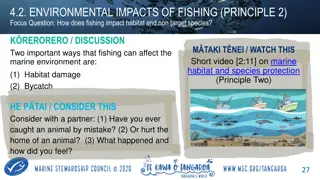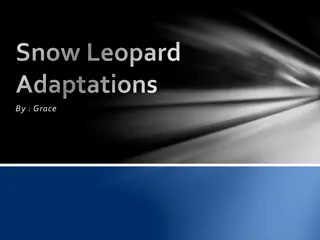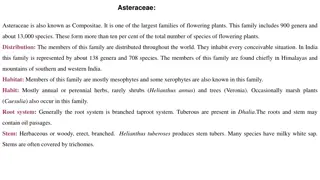The Fascinating Malayan Tapir: Habitat, Range, and Adaptations
The Malayan tapir, the largest of its kind, is uniquely adapted to its habitat in tropical lowland swamps, montane and hill forests. With its distinctive black and white color pattern for camouflage and a prehensile snout for feeding and communication, this species thrives in Myanmar, Thailand, Malaysia, and Sumatra. Efforts are being made to preserve this endangered species due to reasons like habitat loss and hunting.
Download Presentation

Please find below an Image/Link to download the presentation.
The content on the website is provided AS IS for your information and personal use only. It may not be sold, licensed, or shared on other websites without obtaining consent from the author. Download presentation by click this link. If you encounter any issues during the download, it is possible that the publisher has removed the file from their server.
E N D
Presentation Transcript
Biology Biology Living things in Living things in their their Environment Environment Grade 6D Tia Nazha Teresa Alrabadi Kinda Alsamarneh Naya Tadros
Table of contents 02 01 03 Malayan Malayan Tapir Tapir Habitat & Habitat & Range Range Adaptations 04 05 06 Statistics Reasons behind extinction Being done now to preserve
01 Malayan Malayan Tapir Tapir
The M al ayan t ap i r i sthe largest of the four species of tapir, and it's the only one located in Asia. They are al s o t he l arges t o f t he t ap i r s p eci es , wei ghi ng i n at aro und 3 5 0 kg ( 7 20 p o unds ) and gro wi ng 1. 8 m et ers l o ng ( 6 feet ) .
02 Habitat Habitat & Range & Range
Habitat & Range Tropical lowland swamp, montane and hill forests, prefers dense, primary forests. The tapir ranges through Myanmar (Burma) and Thailand south to Malaysia and Sumatra.
03 Adaptations
Adaptations Black White Black Malayan tapirs are sometimes called Oreo tapirs because their distinctive black and white color pattern resembles an Oreo cookie. The black on the front and back with white or gray in the middle is a form of camouflage that breaks up the tapir s outline in the shadows of the forest. The stripes and spots on the vulnerable young help them blend into the dappled sunlight and leaf shadows of the forest and protects them from predators.
Adaptations Prehensile Snout The tapir s upper lip and nose are elongated to form a distinctive prehensile snout that is similar to a stubby elephant s trunk. This flexible extended nose is used for plucking leaves and shoots from trees as well as sniffing their way along forest trails. They have an excellent sense of smell and rely on scents for communication. Urine spraying is used to mark well-used pathways between feeding areas and water sources.
Adaptations Barrel-Shaped Body Tapirs have a thick heavy barrel-shaped body ideal for crashing through dense forest vegetation. When frightened or threatened, tapirs can run quickly. Despite their large size they can climb steep slopes on the banks of rivers. They are excellent swimmers and spend a lot of time in the water.
04 Statistics
Statistics Number of displaced tapirs
Statistics A cco rdi ng t o M al ays i a s Dep art m ent o f Wi l dl i fe and Nat i o nal Parks ( Perhi l i t an) , i n 2017 , a t o t al o f 25 t ap i rs di ed aft er bei ng hi t by vehi cl es . S t at i s t i cs fro m Perhi l i t an s ho w t hat 2, 4 4 4 wi l d ani m al s di ed as a res ul t o f ro adki l l fro m 2012 t o 2017 des p i t e s i gnbo ards p l aced at areas kno wn fo r wi l dl i fe cro s s i ngs . The ram p ant hi t - and- run cas es i nvo l vi ng M al ayan t ap i rs have even garnered t he at t ent i o n o f l o cal p o l i t i ci ans and no n- go vernm ent al o rgani s at i o ns ( NGO s ) .
How many Malayan tapirs are left in the world 2022? 3,000 left in the wild (Endangered). Thi s s t range ani m al co nfus es m any p eo p l e. I t l o o ks l i ke a co m bi nat i o n o f a p i g and an el ep hant , but i t i s act ual l y an ani m al cal l ed t he Tap i r. Tap i rs are m o s t cl o s el y rel at ed t o ho rs es and rhi no s , no t p i gs o r el ep hant s .
05 Reasons behind extinction
Reasons behind extinction The M al ayan t ap i r was firs t l i s t ed as endangered i n 1986 , due t o an o ngo i ng decl i ne fro m loss of available habitat, fragmentation of remaining habitat and increasingly hunting pressure. Tap i rs are cri t i cal l y endangered becaus e t hei r habi t at and envi ro nm ent i s get t i ng rui ned, s o t he o ut co m e m eans t hat t ap i rs wo n' t have a p l ace t o l i ve.
Reasons behind extinction I n fact , t he M al ayan Tap i r i s an eas y t arget fo r s p eedi ng vehi cl es due t o t hei r p o o r eyes i ght . Po achi ng and hunt i ng t ap i rsfor their meat and skin i s al s o o n t he ri s e.
06 Being done now to preserve!
Being done now to preserve! The bes t way t o reco ver t he s p eci es and t hei r ho m e wo ul d be t o reclaim and protect the deforested areas and allow the Malayan tapirs to roam freely and reseed with their diet.
Being done now to preserve! The Wo rl d Tap i r Day i s cel ebrat ed o n A p ri l 27 every year t o rai s e co m m uni t y awarenes s o n t he i m p o rt ance o f co ns ervi ng t ap i rs and t hei r habi t at s .
You can help too! Many Ways to help out: 1. Help the environment by maybe planting some trees or helping the increase of pollution (e.g. putting rubbish in the bin, using ecofriendly lunch boxes, helping the community and help clean up the environment like Volunteer work). 2. Recycle (e.g. use recycled paper, recycle your cell phones, try to always throw out rubbish, using ecofriendly lunch boxes).
3. Reduce and Reuse. 4. Tell others about Tapirs being endangered and start helping the Tapir movement. Thi s wi l l p ro vi de t he t ap i rs wi t h a bet t er envi ro nm ent and a ni cer habi t at where t hey can l i ve.
Stop hunting Stop hunting Tapirs and make Tapirs and make a stand! a stand!
References https://denverzoo.org/animals/malayan-tapir/ https://www.researchgate.net/figure/The-number-of- displaced-Malayan-tapirs-in-Peninsular-Malaysia- from-2006-to-2010_fig3_260292525 https://theaseanpost.com/article/protecting- malayan-tapirs
References https://www.tapirday.org/malayan- tapir.html#:~:text=Conservation%20Status,habitat%2 0and%20increasingly%20hunting%20pressure http://thetapirmovement.weebly.com/save-the- tapirs.html
Thank you! Thank you!




